Mastering the Ever-Increasing Performance and Safety Requirements in Welding
By: Peter Deutsch, Contributor

Figure 1: The bright, clear and true-color view through a modern cassette (example optrel crystal2.0). Photo courtesy of Optrel
The performance and safety requirements in welding are becoming greater. All welders in industry and workshops notice this every day due to the ever-increasing pressure to perform. How can you deal with these rising demands on the welder with confidence? It’s simple: integrate the best technology into a welding helmet to make work easier and safer and simply put it in the welder’s hand (or on his head). As an example, let’s take a look at two technologies that make daily work much safer while also increasing the quality of the work.
What are the challenges of welding? Since the human eye cannot look directly into the welding light, a welding filter must be used. Today, welding filters automatically darken when welding begins (ADF = auto darkening filter). This leaves both hands free to work and gives a more or less good view of the component before welding. The brighter the filter is when the welder is not welding, the better.
In addition to darkening, the ADF has another fundamentally important function, namely filtering out dangerous UV and IR radiation. This filter element in every ADF is one of the most expensive components in an ADF. Therefore, a simple filter is often used that protects well, but does not transmit all visible colors. These filters can be recognized by the fact that the welding arc and everything around it can be seen in green or orange. However, this is a significant disadvantage in welding. Welding temper colors and marks can hardly be seen, and the welding pool cannot be seen clearly.
Solving Common Challenges

Figure 2: Continuous adjustment of the darkening with the optrel ShadeTronic®. Photo courtesy of Optrel
In the meantime, however, there are welding helmets with ADFs on the market that solve this exact problem. Through an elaborate manufacturing process, technology is now available that enables both an open shade level of 2 and a really true color view of the welding process. An example of this is CL Technology (CLT). This technology gives the welder an unprecedented bright, clear and true-color view also when the helmet is open (Figure 1). This allows the helmet to be worn throughout the work process without having to constantly flip it up and down. This saves time and prevents work interruptions due to poor visibility, while at the same time protecting the workers’ eyes from debris and other welders in the area. In the dark state during welding, the CLT now provides an unprecedented view of the arc and the component being welded. The welder can see every subtlety in the arc and the molten metal and can finally fully control the arc. Furthermore, the welding temper colors during welding can now be seen completely, which allows ideal control of the heat input. This makes welding much easier and prevents expensive and time-consuming welding errors, such as binding errors or a heat-affect zone that is too large.
What other challenges does the welder face?
With modern welding power sources, the welder can adapt his arc (welding current) to the component during welding. For example, with a foot pedal or a torch switch in TIG welding, the welding power can be continuously increased or decreased according to the requirements. However, this also means that the brightness of the arc increases or decreases accordingly. This is exactly where the welder with an ordinary automatic helmet has a problem. The shade level is then no longer appropriate for the amperage being used.
Crafty engineers have also found a perfect solution to this problem: An ADF that also automatically adjusts to the brightness of the arc. With this technology, an automatic helmet now becomes a fully automatic helmet. The “automatic” of ordinary welding helmets refers, as already mentioned, only to the darkening of the ADF.
Automatic shade level adjustment, however, goes one decisive step further: the shade level of the ADF adapts fully automatically to the brightness of the arc. This means that the welder always has the correct protection level setting and always has a perfect view of the arc, thus preventing eye fatigue and eye strain often leading to headaches while welding at the incorrect shade level. This also works when the welding power is changed during welding, e.g. when changing from main current to secondary current. Here, the darkening level automatically and continuously follows the brightness of the arc (Fig. 2). Previously, the welder only had the choice between, for example, “too bright with secondary current” or “too dark with main current.” This not only made the eyes very tired, but also preprogrammed welding errors due to the lack of visibility. With this technology, this shortcoming of ordinary welding helmets is finally eliminated. And since every welder has an individual perception of brightness, the brightness can also be adjusted by +/-2 protection levels.
As these two examples of technical progress show, a small investment in an innovative welding helmet can make work considerably easier and safer. By avoiding errors and increasing productivity – while at the same time relieving the welder – the investment pays for itself in a very short time. WMHS
Peter Deutsch is a welding engineer (IWE) and head of Product Management for Optrel, a leading global supplier of face and head protection products, breathing protection solutions and active sunglasses (www.optrel.us).



